The advent of 3D printing techniques in the modern era has created a surging wave of interest within many manufacturing industries across the country and the world. And the rate at which the technology is advancing is staggering, to say the least.
A recent paper by Dr. Jean-Marie Floch et al. entitled “New Compact Broadband GSM/UMTS/LTE Antenna Realised by 3D Printing” introduces a revolutionary omni-directional radiation pattern device for mobile communications. The prototype is a complex three-dimensional shape achieved via an optimization process that involves using commercial applications to fold two ellipses  several times. The end result is a broadband antenna that meets the growing necessity of data exchange.
several times. The end result is a broadband antenna that meets the growing necessity of data exchange.
Deconstructing the Printing Process
The device is first fabricated via Acrylonitrile Butadiene Styrene (ABS), a durable plastic. A silver printing metallization layer is then applied over the prototype. With its performance-based elliptical design, the omni-directional antenna is fitted with a short circuit to achieve the low-frequency bands that are its milestone targets.
The position of the short circuit is calculated to feed the antenna a coaxial line with an input impedance of 50 Ohm – the optimal rate for the efficient transfer of information via wireless technologies. All in all, the folding process brings the antenna’s total height down by a factor of three to where it measures just 1.25” – a remarkable step forward in development.

Measured radiation pattern of the proposed antenna in
different frequencies. (a) at the 0.7 GHz, (b) at the 0.960 GHz, (c)
at the 2 GHz and (d) at the 2.7 GHz
The prototype’s capacity to satisfy stringent frequency band requirements at such a reduced size when compared to its competition make it a promising breakthrough in the field of broadband systems and mobile communication.
The New Paradigm in 3D Printing Capabilities
As a key component in communication networks, the new method of manufacture allows for greater scope in design and experimentation with unorthodox geometries to galvanize the production of the next generation of antennae. Previously, the functionality of 3D printers was restricted to select industries, but as the limitations of materials – ceramic, glass, metals, and some others – began to lift, a wider array of environmental, mechanical, and medical applications became available. Now, companies are able to offer a range of printing and modeling services targeted at industry and entrepreneurs alike.
Experimentation with Bandwidth Impedance
As previously stated, achieving positive results at the desired frequency bands of 700 to 2700 MHz requires a wide impedance bandwidth that’s capable of covering the GSM, UMTS, and LTE bands. This is necessary for the compact broadband antenna to properly respond to and integrate with the recently implemented 4G communication network.
When tested at its maximum 5dB gain, the antenna reports an average radiation efficiency of 65 percent. It also shows a good agreement during simulation where measured return losses were concerned. Not surprisingly, the antenna’s efficiency was more than 50 percent in the lower band and reached as high as 70 percent in the higher band. Based on these tentative results and assuming the suitability of the 3D manufacturing process for large-scale wireless communication projects, the world may come to look considerably different in the very near future.
In fact, the printers themselves can be acquired for as little as $330, making them a cost-effective proposition for any organization in the business of manufacturing or tasked with presenting innovative solutions to the problems of tomorrow.
Though we are just beginning to push the limits of the technology, the documented performance of this antenna proves that 3D printing techniques are not only feasible, but reliable and precise. Surely other industries and the businesses working within them will be motivated to adopt a similar 3D printing strategy – if not now, then soon.
Let us know what you think about this latest research into 3D printed antennae in the Compact Broadband Antennae forum thread at 3DPB.com.
Subscribe to Our Email Newsletter
Stay up-to-date on all the latest news from the 3D printing industry and receive information and offers from third party vendors.
You May Also Like
3D Printing News Briefs, April 27, 2024: Research, Digital Dentistry, Cycling, & More
We’re starting today’s 3D Printing News Briefs with some research into 3D printed luminescent quantum-dot polymer architectures and free-form laser beam shaping, and then on to an open source 4-axis...
HP & INDO-MIM Collaborate to Boost Metal 3D Printing in India
HP Inc. and INDO-MIM, a US- and India-based supplier of metal injection molding (MIM) powders and contract manufacturer, have announced that the two companies will collaborate to accelerate additive manufacturing...
3D Printing News Briefs, February 17, 2024: Shot Blasting, Service Bureaus, & More
In today’s 3D Printing News Briefs, we’re starting out with post-processing, as SKZ Würzburg is using a shot blast system from AM Solutions for its research. Moving on to business,...
3D Printing News Unpeeled: Not That Kind of Organ 3D Printing
GKN Aerospace will create a 150 jobs in Trollhattan Sweden with an investment of $60 million part of which comes from the Swedish Energy Agency’s Industriklivet initiative. The investment will...































